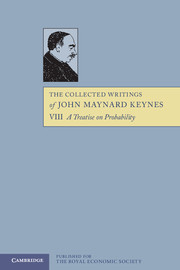Book contents
- Frontmatter
- Contents
- General Introduction
- Editorial Foreword by R. B. Braithwaite
- Editorial Note
- Preface to the First Edition
- I FUNDAMENTAL IDEAS
- II FUNDAMENTAL THEOREMS
- 10 INTRODUCTORY
- 11 THE THEORY OF GROUPS, WITH SPECIAL REFERENCE TO LOGICAL CONSISTENCE, INFERENCE, AND LOGICAL PRIORITY
- 12 THE DEFINITIONS AND AXIOMS OF INFERENCE AND PROBABILITY
- 13 THE FUNDAMENTAL THEOREMS OF NECESSARY INFERENCE
- 14 THE FUNDAMENTAL THEOREMS OF PROBABLE INFERENCE
- 15 NUMERICAL MEASUREMENT AND APPROXIMATION OF PROBABILITIES
- 16 OBSERVATIONS ON THE THEOREMS OF CHAPTER 14 AND THEIR DEVELOPMENTS, INCLUDING TESTIMONY
- 17 SOME PROBLEMS IN INVERSE PROBABILITY, INCLUDING AVERAGES
- III INDUCTION AND ANALOGY
- IV SOME PHILOSOPHICAL APPLICATIONS OF PROBABILITY
- V THE FOUNDATIONS OF STATISTICAL INFERENCE
- Bibliography
- Index
16 - OBSERVATIONS ON THE THEOREMS OF CHAPTER 14 AND THEIR DEVELOPMENTS, INCLUDING TESTIMONY
from II - FUNDAMENTAL THEOREMS
Published online by Cambridge University Press: 05 November 2012
- Frontmatter
- Contents
- General Introduction
- Editorial Foreword by R. B. Braithwaite
- Editorial Note
- Preface to the First Edition
- I FUNDAMENTAL IDEAS
- II FUNDAMENTAL THEOREMS
- 10 INTRODUCTORY
- 11 THE THEORY OF GROUPS, WITH SPECIAL REFERENCE TO LOGICAL CONSISTENCE, INFERENCE, AND LOGICAL PRIORITY
- 12 THE DEFINITIONS AND AXIOMS OF INFERENCE AND PROBABILITY
- 13 THE FUNDAMENTAL THEOREMS OF NECESSARY INFERENCE
- 14 THE FUNDAMENTAL THEOREMS OF PROBABLE INFERENCE
- 15 NUMERICAL MEASUREMENT AND APPROXIMATION OF PROBABILITIES
- 16 OBSERVATIONS ON THE THEOREMS OF CHAPTER 14 AND THEIR DEVELOPMENTS, INCLUDING TESTIMONY
- 17 SOME PROBLEMS IN INVERSE PROBABILITY, INCLUDING AVERAGES
- III INDUCTION AND ANALOGY
- IV SOME PHILOSOPHICAL APPLICATIONS OF PROBABILITY
- V THE FOUNDATIONS OF STATISTICAL INFERENCE
- Bibliography
- Index
Summary
1. In Definition XIII of chapter 12 a meaning was given to the statement that a1/h and a2/h are independent arguments. In Theorem (33) of chapter 14 it was shown that, if a1/h and a2/h are independent, a1a2/h = a1/h.a2/h. Thus where on given evidence there is independence between a1 and a2, the probability on this evidence of a1a2 jointly is the product of the probabilities of a1 and a2 separately. It is difficult to apply mathematical reasoning to the calculus of probabilities unless this condition is fulfilled; and the fulfilment of the condition has often been assumed too lightly. A good many of the most misleading fallacies in the theory of probability have been due to a use of the multiplication theorem in its simplified form in cases where this is illegitimate.
2. These fallacies have been partly due to the absence of a clear understanding as to what is meant by independence. Students of probability have thought of the independence of events, rather than of the independence of arguments or propositions. The one phraseology is, perhaps, as legitimate as the other; but when we speak of the dependence of events, we are led to believe that the question is one of direct causal dependence, two events being dependent if the occurrence of one is a part cause or a possible part cause of the occurrence of the other.
- Type
- Chapter
- Information
- The Collected Writings of John Maynard Keynes , pp. 181 - 205Publisher: Royal Economic SocietyPrint publication year: 1978



